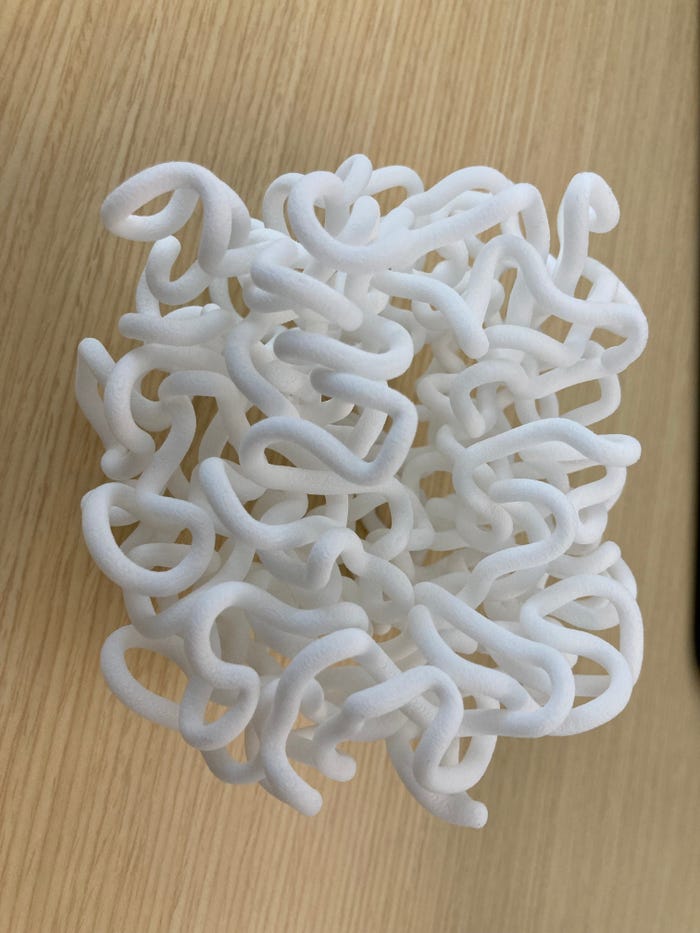Digital Manufacturing Turns Information into Reality
Generative AI and digital manufacturing can benefit from information theory and the study of complexity.

At a Glance
- 3D printing and artificial intelligence
- Information theory
- Digital manufacturing and digital twins
Look around you. No matter what direction you turn, everything you see has a story attached to it. How was it formed? What is it used for? Some things, however, have deeper meaning if you have the knowledge to decode the information embedded in them.
Imagine this scenario: You’re digging a hole in your yard for a garden. After a few shovels full of dirt and rocks, you come across a stone arrowhead. It may be made of the same material as the stones that surround it, but its special shape informs us that it is rare, unique, and surprising. It doesn’t have notably more mass or energy than the other rocks, but because of its unique shape it contains much more encoded information, perhaps about the past, its purpose, or the people who manufactured it. Certainly, there’s more to the story than a typical rock could provide. Inevitably, we want to know more.
In the accounting of information, the environment owes us an explanation for how this arrowhead came to be and why it is so special compared to the other rocks. After all, it had to get there somehow! In other words, in this inanimate object there lies embedded a longer “story” or “procedure” that explains how it came to exist. It’s not just a regular rock; it’s filled with information.
AI, Entropy, and 3D Printing
My area of specialization is 3D printing, but I’ve been fascinated by the recent surge of interest in artificial intelligence (AI). Lately, there has been a spotlight on research about information and complexity. While this might seem tangential to the world of additive manufacturing, there are surprising correlations that can deepen your knowledge of 3D printing processes, rapid prototyping, and digital manufacturing.
Information theory suggests that information follows entropic behavior—a tendency toward chaos and disorder—just as many theoreticians used to view heat or other forms of energy. It is easy to write off the study of information as “computer stuff,” but in truth it isn’t removed from physical reality, and 3D-printed parts are real. Beyond computation, there are interesting applications being studied in fields like astronomy and biology.
So, is the information embedded in 3D-printed objects chaotic or ordered? Some parts seem chaotic (such as the example of the Boltzmann’s Brain below), but they often have incredibly rich, detailed stories about their production, as well as their natural state. I would argue the most interesting and useful 3D-printed objects tend to be considered complex, and complexity is believed to live somewhere between order and chaos at the edge of chaos.
New technologies, such as generative AI and digital manufacturing can benefit from information theory and the study of complexity. They offer an indication of what may be possible in the future as we move closer to a unification of AI and manufacturing technologies.
Prototyping Information-Rich Objects
What is it that makes 3D printing so fascinating? Much of the appeal is in the novel parts that are created. Watching them grow, layer-by-layer, is captivating. The truth is 3D printing is just a means to an end. What we are really doing is creating objects with low Shannon entropy. What does that mean?
Objects like the arrowhead we discussed earlier that are surprising and information-rich are considered to have low Shannon entropy. Objects that are common and non-surprising have high Shannon entropy and relatively little information can be extracted. Almost by definition, objects of low Shannon entropy are interesting and intriguing, and objects of high Shannon entropy tend to be boring because there’s nothing for you to hang your hat on that allows you to understand it at a deeper level.
Here’s where we link back to additive manufacturing. 3D-printed prototypes are like the arrowhead and are objects with very low Shannon entropy. They may be room temperature to the touch, but they are white hot with information. Just like the physical shape of a key allows it to open a specific lock, the special shape and material of a prototype object allows us to “unlock” information from the physical world.
What questions do you want the prototype to answer? Does it feel and look right? Does it work as intended as part of an assembly? Will it sell? What is its material and its end-use purpose? How do these geometries achieve the designer/engineers’ goal?
There is a relationship between the questions answered and the necessary requirements. The more questions you expect the prototype to answer, the more you need to describe it initially in your requirements. You may need several variants or multiple copies to increase the answer's fidelity. This allows you to make conclusions more reliably about the object. So, in the end, increasing the number of samples offers you greater precision of description because patterns in the part builds become more apparent when you have more content to evaluate.
In manufacturing, the description of the object is called its “requirements.” Regardless of the manufacturing process, if more information is needed to describe the object, that makes it more special and requires a longer “story” to manufacture accurately. Low Shannon entropy yields high information content.
Bit to It
A tremendous advantage of digital manufacturing is the existence of the digital twin, which is a digital representation of the pre-manufactured part. The digital twin fully captures the requirements of the object and the manufacturing process required to create it. But at some point, the rubber needs to hit the road and all those 1s and 0s need to be converted into a physical object. How does that happen?
At this point, you may have realized I am using “story” and “procedure” interchangeably. What I’m getting at is that I have a generalized idea of taking an input, providing a series of steps and instructions, and getting a transformed output. This can take many names depending on the discipline. Mathematicians may call it a function; a baker may call it a recipe, but the underlying idea is the same. These procedures are usually made up of smaller bits of instruction, most commonly referred to as tasks.
A common saying in the 3D printing industry is that complexity is free. Although this is not quite true as someone must pay for printing time and materials, it is true that complexity is a lot cheaper than in conventional manufacturing. But why is this so?
Let’s take an example of manufacturing a simple cube. To manufacture it, there has to be a procedure describing how it comes to exist. If I wanted to write a procedure for making a cube using subtractive means, such as CNC machining, I really need six simplified tasks; one to cut each flat plane from a block of material. The instructions could literally be written on a post-it note by hand.
However, a “procedure” to 3D-print a cube requires a step-by-step, iterative process to get that shape, and it must be done digitally, prior to the actual print. We need to take the STL file and encode it in a way that the part is sliced into thin layers that encompass machine instruction for the 3D printer. The resulting slice files can be huge, maybe as many as a few gigabytes of instructions for complex parts. It can take hundreds or thousands of specific instructions for the print head or laser to execute so it can make something as simple as a cube. For even a very simple part, 3D printing must tell a very long story about how to create it. For a 3D printer that draws with an extrusion head or laser, in a very real sense the part is written into existence.
Compared to other manufacturing processes, it’s more accurate to say that complexity is front-loaded in 3D printing. Making the cube geometry more complex, for example adding several holes to it, does not result in a meaningful increase in the “procedure” needed to create it. The 3D printer now must draw the outline of the holes but in turn doesn’t have to ‘scribble’ to fill it in. Adding features like holes can reduce the print time, unless the number of holes is so high that drawing the borders takes more time than it would have been to just fill them with material. For some voxel-based 3D printing technologies like Multi Jet Fusion, it doesn’t matter at all whether the part has a hole or not in terms of effect on print time. For a voxel-based printer, a hole is essentially a flipped bit of information, not an addition or subtraction of information.
This front-loading is also what gives 3D printing its magical quality. With just casual observation, the parts seem to appear out of nowhere—without explanation. In reality, the informational accounting is happening before the print kicks off, and the story of how the part came to be is written in real time as it is printed.
Blending Boltzmann’s Brain
I decided to conduct a Shannon entropy experiment and made a demonstrative part with the help of Blender and its powerful Simulation Nodes. Given its appearance, the fact that it has a memory, and that it blinked into existence with all its complexity intact, I am going to call this a Boltzmann Brain. It’s roughly six meters of continuous polyamide (nylon) made using selective laser sintering (SLS) wherein no surface touches another surface.

a Shannon entropy experiment. Image courtesy of Protolabs.
Though it looks chaotic, the brain’s folds follow specific rules, never intersect and are equidistant from each other. The memory is in these folds, and it allows the object to remember its initial shape even when bent out of it. You can stretch it into a loop, pose it, twist it (not too much, though), and with a few shakes it uncannily returns to its original shape. Though it is a single piece of plastic, it acts as a dynamic system that can change states. That sounds fancy, but other objects, like a Rubik’s Cube or an abacus, are also considered dynamic systems. Bending it out of shape adds information to the system and makes it more special and differentiated. Shaking it is comparable to shaking an Etch-a-Sketch—it erases the information in the system, taking it back to its original shape.
About the Author(s)
You May Also Like





